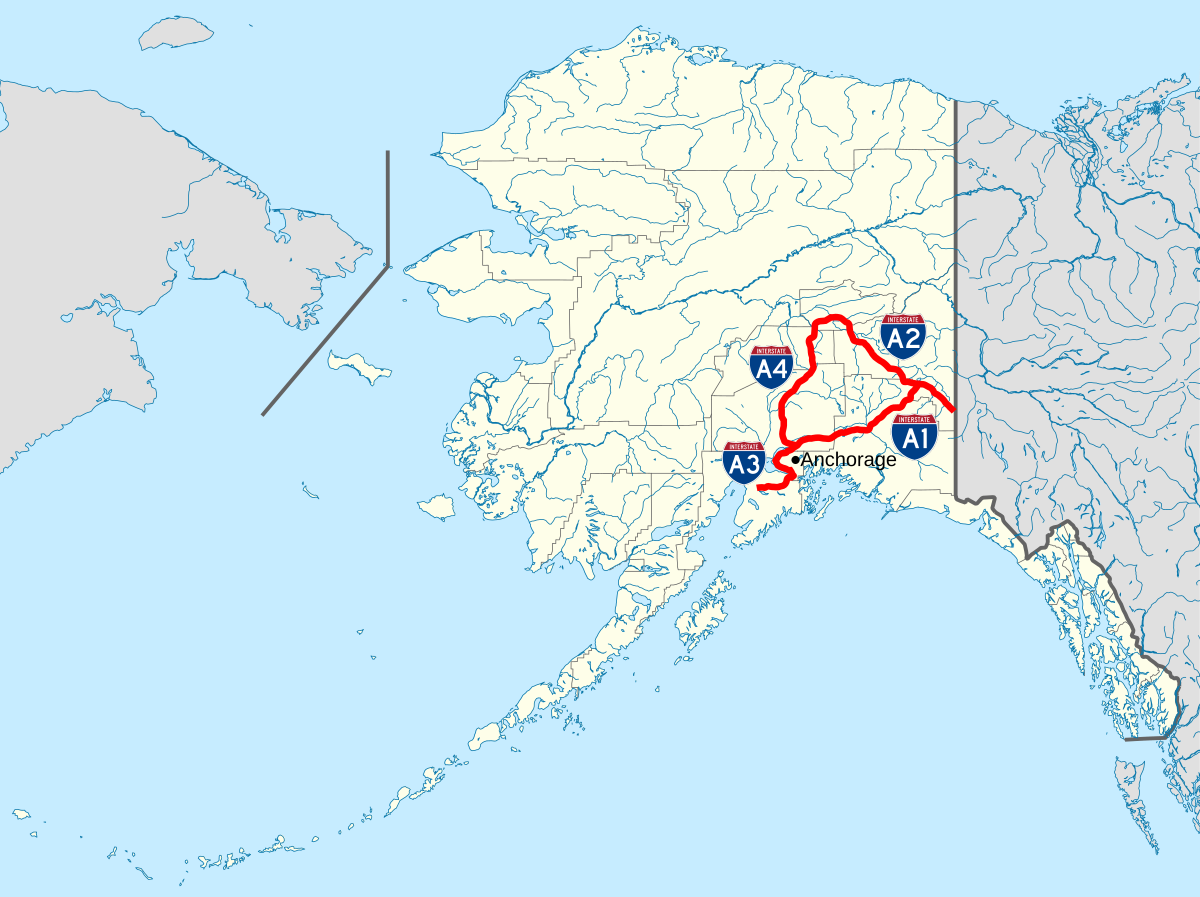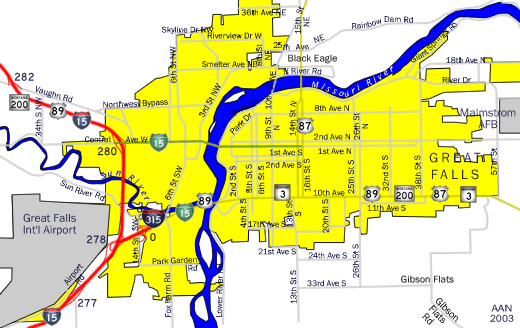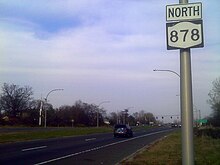The Unsigned Interstate Highways
Despite being the highest standard of highway in the world, the Interstate Highway System has a few highways which, despite being fully part of the system, do not carry such a signed designation. This mirrors Illinois' Unmarked Highway System, although there are far fewer unsigned Interstates.
Interstate 444 is the final piece to the puzzle that is the Interstate System in Tulsa, OK, but as the road continues both north and south of the Interstate's endpoints as US-75, and with the possibility that an emergency dispatcher may confuse an incident on I-444 with one on I-44, it's more simple to keep the route as US-75.
Changing from Signed to Unsigned:
Like with Hawaii's I-H201, a highway's status as an unsigned route is not set in stone, and various state DOT's occasionally change their mind with regard to Interstate highways. As we showed I-296 in Michigan with a sign, albeit one for a photo-op, this is one example where a highway was initially signed. That said, no example might be better than Tennessee's Interstate 124.
First opening in the 1960's, I-124 runs less than two miles in the Chattanooga, TN area along with US-27. In 1986, the route began its decline toward unsigned status, as it would disappear and reappear on maps, with the reasoning being that motorists confused it with I-24. After a reconstruction project, none of the 124 shields were replaced, leaving just one along the entire route, before fully being taken off the route in 2003. While the road is no longer signed as an Interstate, it still exists on paper, just like all unsigned routes.
 |
| Image: Grand Rapids Public Library via Fox 17 online |
Interstate-Guide.com maintains a list of unsigned Interstate Highways.
Since I began learning about the Interstate System in my youth, the fact that there existed "hidden" Interstates fascinated me. Today we'll go over some of these routes, and why they aren't signed as an Interstate.
Alaska & Puerto Rico:
The Interstate Highway System at its inception was much different than it is today, with regard to funding. During the initial construction of the system, 90% of the funds for the roads were provided by the Federal Government. Most Interstate highway projects today are funded with a mix of federal, state and local funds.
The Interstate Highway System at its inception was much different than it is today, with regard to funding. During the initial construction of the system, 90% of the funds for the roads were provided by the Federal Government. Most Interstate highway projects today are funded with a mix of federal, state and local funds.
Despite existing outside the contiguous 48 states, Alaska, Hawaii and Puerto Rico were included in this funding mix for upgrading and building its own highways, which is why there are Interstates in these states and territory. Neither Alaska nor Hawaii were states in 1956.
Alaska, which only has Anchorage as a major population center, has four unsigned interstates; I-A1, I-A2, I-A3 and I-A4, which do not conform to the standards of the contiguous United States. Puerto Rico similarly has I-PR1, I-PR2 and I-PR3. This practice is codified in Section 103(c)(1)(B)(ii), 23 U.S.C., which states , "Highways on the Interstate System in Alaska and Puerto Rico shall be designed in accordance with such geometric and construction standards as are adequate for current and probable future traffic demands and the needs of the locality of the highway." (FHWA)
 |
| Alaska's Interstates, All Unsigned. Image: Wikipedia Commons |
 |
| Puerto Rico's Unsigned Interstates. Image: Wikipedia Commons |
Hawaii, having an urban population center in Honolulu, was able to build freeways consistent with the contiguous US, and signed them as I-H1, I-H2, I-H3 and I-H201. I-H201 was initially signed as HI-78, but has been signed since 2004.
Too Short to Sign:
Back in the mainland US, there exist several Interstate highways that are so short, it is simply better to not sign them. This is generally the reasoning behind not numbering Interstate highways, as the vast majority of unsigned routes are less than four miles in length.
Examples of this include I-315 in Montana, which runs less than a mile in length in Great Falls, MT. The entire route is signed as BL-15, which runs into the downtown area, and is not Interstate standard east of Fox Farm Rd.
 |
| Map of I-315 and BL-15 in Great Falls. Image: Interstate-Guide.com |
I've talked before about I-878 in New York, which was planned to be much longer than it exists as today. 878 as an Interstate officially exists (or existed) for all of 7/10 of a mile near JFK airport. In this case, the State of New York created a similarly numbered route along part of the planned Nassau Expy, and thus saw no need to sign 878 as anything else but a state route.
Another short, unsigned Interstate Highway that was planned to be a much longer route is I-478 in New York, better known as the Brooklyn-Battery Tunnel (or the Hugh L. Carey Tunnel). What's interesting is that New York City and State both freely acknowledge the number, and it's even signed on Google Maps, but no physical signs exist with the 478 designation.
 |
| Image: Untapped Cities |
 |
| I-444 in red. Image: Wikipedia Commons |
Disagreements between Federal and State DOT's:
Occasionally, a state has a differing opinion on the numbering of a route than the Federal Government, although this is an uncommon situation. Currently, Interstate 910 exists in Louisiana from a junction with I-10 to US-90 along current Business US-90 (which ironically, is up to higher standards than US-90 itself). The FHWA approved signage in 1999, however Louisiana never acted upon it, instead preferring to wait until I-49 is extended into the New Orleans area for the route to become signed as an Interstate.
Occasionally, a state has a differing opinion on the numbering of a route than the Federal Government, although this is an uncommon situation. Currently, Interstate 910 exists in Louisiana from a junction with I-10 to US-90 along current Business US-90 (which ironically, is up to higher standards than US-90 itself). The FHWA approved signage in 1999, however Louisiana never acted upon it, instead preferring to wait until I-49 is extended into the New Orleans area for the route to become signed as an Interstate.
 |
| I-910 along Business US-90 in red. Image: Mr Matte, Wikipedia Commons |
Like with Hawaii's I-H201, a highway's status as an unsigned route is not set in stone, and various state DOT's occasionally change their mind with regard to Interstate highways. As we showed I-296 in Michigan with a sign, albeit one for a photo-op, this is one example where a highway was initially signed. That said, no example might be better than Tennessee's Interstate 124.
 |
| Michael Summa, 1975 via Interstate-Guide.com |
And now we move to the final category of unsigned highways.
It Really Ought to Be Signed:
While generally unsigned Interstate highways, like the ones mentioned above, have a decent reason to be unsigned, there exists an unsigned Interstate in Maryland that is longer than a main route of the system, with which it shares an interchange. That route is I-595.
It Really Ought to Be Signed:
While generally unsigned Interstate highways, like the ones mentioned above, have a decent reason to be unsigned, there exists an unsigned Interstate in Maryland that is longer than a main route of the system, with which it shares an interchange. That route is I-595.
 |
| Route of the unsigned I-595 between I-95/495 and MD-70. Image: Alchetron |
At almost 20 miles in length, I-595 is about as long as the average 3-digit Interstate Highway, and two miles longer than I-97, which is by far the shortest 2-digit Interstate Highway at just 17 miles in length. I-595 runs along the well-known US-50/301, which is the explanation for keeping the route unsigned (despite that numerous US Routes and Interstates run concurrently).
The road has a pretty long history, as it was first proposed to become part of I-68 in 1975. AASHTO rejected that idea, but approved extending I-97 westward, and making the road east of I-97 Interstate 197.
Maryland continued to push for I-68, but that never materialized, as I-68 was to be applied to a road in Western Maryland and West Virginia, from I-79 to I-70 in Morgantown, WV and Hagerstown, MD, respectively. Once the road was fully brought up to Interstate Standards, AASHTO approved I-595 for the route, but Maryland chose not to sign the route. Maybe they're waiting for an eastward extension of I-68, who knows. Their reasoning, according to a response to a 2001 email from Scott M. Kozel, was that "we did not feel that either the posting in the field or the noting on a map would serve any useful purpose for the traveling public".
Nonetheless, the designation is occasionally referred to on Maryland's traffic information website, CHART.
Thanks as always for reading!




There is also Interstate 1345 in Dallas -- Runs concurrently with US75 from I-30/I-45 to TX-366
ReplyDeleteThat was supposed to be I-345
DeleteWhat is the section of I-10 West in Los Angeles supposed to be numbered after it breaks off and leaves a segment about a mile or two long before it becomes US 101? The GPS tells you to remain on “The current highway” when driving east bound until it connects with I-10, so there is this one section of unnumbered freeway right in the middle of Los Angeles.
ReplyDelete